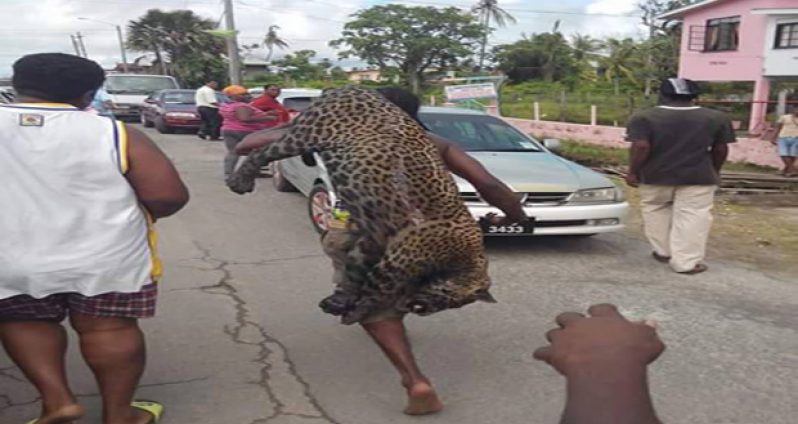IN light of the recent shooting of a young male jaguar in New Amsterdam, Berbice, activists are calling for greater wildlife protection awareness to prevent such occurrences in the future.
Some felt the Jaguar overstepped its mark and deserved its fate, while some argued that it was “a wrong move”. Among those who shared the view that the response to the situation was a “typical” one are long-standing animal activists, Annette Arjoon-Martins and Syeada Manbodh.
Both Martins and Manbodh believe that this is a starting point for all wildlife agencies to unite and develop a strategy for combating the issue of jaguars overstepping their boundaries. The cause of the jaguar’s death is said to have stemmed from the lack of awareness as residents felt the only alternative was to corner the animal and riddle it with bullets.
LACK OF AWARENESS
“If they [residents] were educated on how to handle the situation, they would’ve reacted differently,” said Martins.
However, the situation, said Martins, who is also a wildlife protection activist, could not have been dealt with differently, given that the residents were not educated on how to react under such circumstances. With the steady growth of the wild-meat trade, she stressed that this among other factors contribute to the encroaching of jaguars on human territory.
Such businesses have caused a reduction of food for animals in the wild, which has led to jaguar encroachments. Manbodh, on the other hand, believes that land degradation has significantly contributed to this encroachment,since animals such as the jaguar are forced to evacuate their natural habitats and dwell elsewhere.
Human and Natural Environment Interactions Researcher from the University of Texas at Dallas, Anthony R. Cummings, has expressed similar views to that of Martins and Manbodh, and has emphasised that a lot could be done to reduce the incidence of jaguar killings, so as to rescue the animal from extinction.
Until a unit is set up to specifically deal with these issues, Cummings said, a few less extreme measures can be taken to avoid another such scenario.
Jaguars are afraid of loud noises, said Cummings, therefore cattle farmers should attach bells to their cows to startle lurking jaguars,which should aid in preventing extreme measures if another jaguar invades, suggested the researcher.
Cummings also highlighted the fact that jaguars are less vicious when compared to the pumas and ocelots, and would not attack, unless they feel overpowered.
JAGUAR ALERT
Shooter of the jaguar, 52-year-old businessman Errol Azar, recalled his experience when he saved the New Amsterdam community from sleepless nights by firing four shots at the jaguar, resulting in its death.
Azar said he was awakened by a call about a jaguar in the community early yesterday morning. Armed with his guns, he took off to rid the villagers of this fear.
After countless efforts, he caught the animal hiding in a forested area and ventured out to shoot it. Three shots were fired at first, but this did not stop the animal from approaching Azar, who fired a fourth shot to its head, resulting in its demise.
Azar said the animal was unusual in size, as it was gigantic and seemed extremely healthy. Jaguars are known to have a 50-Kilometre territorial space. As such, Azar said the animal felt it was his territory, since it took him countless efforts to trace it in the township.
“I love animals, but when it comes to safety, I would do it again,” said a bold Azar.
The “Hero of New Amsterdam” said that there were no other alternatives in dealing with the situation, as the residents were in genuine fear.
Residents praised Azar’s efforts, while noting that there are many school-aged children in the community and it would have been heartbreaking if one had been attacked and mauled by the animal.
Jaguars are often seen at the basin of the Canje River in Berbice. Therefore, the possibility of more such incidents occurring is very high. Jaguars are Guyana’s national animals, and are slowly heading into extinction. As such, Martins and Manbodh are calling on the relevant authorities to provide laws with “teeth” to protect the specie.












